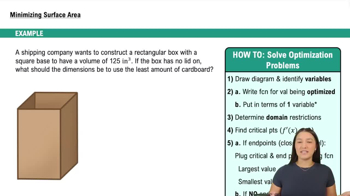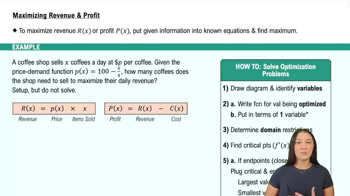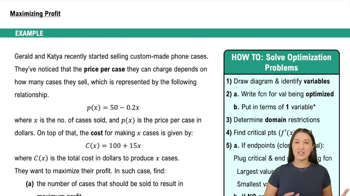Table of contents
- 0. Functions7h 52m
- Introduction to Functions16m
- Piecewise Functions10m
- Properties of Functions9m
- Common Functions1h 8m
- Transformations5m
- Combining Functions27m
- Exponent rules32m
- Exponential Functions28m
- Logarithmic Functions24m
- Properties of Logarithms34m
- Exponential & Logarithmic Equations35m
- Introduction to Trigonometric Functions38m
- Graphs of Trigonometric Functions44m
- Trigonometric Identities47m
- Inverse Trigonometric Functions48m
- 1. Limits and Continuity2h 2m
- 2. Intro to Derivatives1h 33m
- 3. Techniques of Differentiation3h 18m
- 4. Applications of Derivatives2h 38m
- 5. Graphical Applications of Derivatives6h 2m
- 6. Derivatives of Inverse, Exponential, & Logarithmic Functions2h 37m
- 7. Antiderivatives & Indefinite Integrals1h 26m
- 8. Definite Integrals3h 25m
5. Graphical Applications of Derivatives
Applied Optimization
Problem 4.3.111c
Textbook Question
Population models The population of a species is given by the function P(t) = Kt²/(t² + b) , where t ≥ 0 is measured in years and K and b are positive real numbers.
c. For arbitrary positive values of K and b, when does the maximum growth rate occur (in terms of K and b)?
 Verified step by step guidance
Verified step by step guidance1
Identify the function for population growth, P(t) = Kt²/(t² + b), and recognize that to find the maximum growth rate, we need to differentiate this function with respect to time t.
Calculate the first derivative of P(t) using the quotient rule, which states that if you have a function in the form of f(t) = g(t)/h(t), then f'(t) = (g'(t)h(t) - g(t)h'(t)) / (h(t))².
Set the first derivative P'(t) equal to zero to find the critical points, as these points will help us determine where the maximum growth rate occurs.
Analyze the critical points found in the previous step by using the second derivative test or by evaluating the first derivative around those points to confirm whether they correspond to a maximum.
Express the time t at which the maximum growth rate occurs in terms of K and b, ensuring that the solution is simplified and clearly shows the relationship between these variables.
Recommended similar problem, with video answer:
 Verified Solution
Verified SolutionThis video solution was recommended by our tutors as helpful for the problem above
Video duration:
8mPlay a video:
Was this helpful?

 1:13m
1:13mWatch next
Master Intro to Applied Optimization: Maximizing Area with a bite sized video explanation from Callie
Start learningRelated Videos
Related Practice









